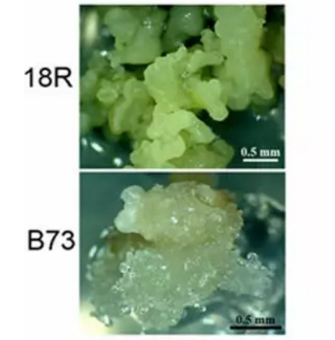如何提高玉米胚性愈伤诱导率?
作者:yms 审稿人: 时间: 2017-04-25 点击次数:次
胚性愈伤的诱导率是决定转化效率高低的重要指标,分析胚性愈伤诱导条件对于植物转化体系建立和改善具有重要的意义。最近,我校的科研人员对玉米胚性愈伤进行了蛋白组和代谢组的分析,试图揭示出玉米胚性愈伤诱导的分子机制。
研究人员选取两个玉米自交系:一个是高诱导率的18-599R,另一个是低诱导率的B73,对其分别用iTRAQ和LC-MS分析了蛋白质谱和代谢谱。结果显示,两个自交系在愈伤诱导过程中,很多代谢途径都存在着差异,它们对外界环境的反应也有所不同。生长素、细胞分裂素、赤霉素、水杨酸、茉莉酸、油菜素内酯和乙烯等激素合成和转导能力的差异是导致诱导率高低的重要原因。此外,在18-599R愈伤诱导过程中,HD2组蛋白去乙酰化酶和ERF转录因子复合体对下游基因表达的激活作用受到抑制,这也进一步造成了18-599R的高愈伤诱导率。
该研究从蛋白质组学和代谢组学的角度分析了玉米胚性愈伤诱导的分子机理,这不仅阐述了愈伤诱导这一组培重要阶段的调控机制,而且为提高诱导率、优化玉米转化体系提供了新的思路。
Sci Rep. 2017 Apr 21; 7 (1): 1004.
Metabolomic and Proteomic Analysis of Maize Embryonic Callus induced from immature embryo.
Author
Ge F, Hu H, Huang X……Gao S, Pan G, Shen Y.
Key Laboratory of Biology and Genetic Improvement of Maize in Southwest Region, Maize Research Institute, Sichuan Agricultural University, China.
Abstract
The low ratio of embryonic callus (EC) induction has inhibited the rapid development of maize genetic engineering. Still, little is known to explain the genotype-dependence of EC induction. Here, we performed a large-scale, quantitative analysis of the maize EC metabolome and proteome at three typical induction stages in two inbred lines with a range of EC induction capabilities. Comparison of the metabolomes and proteomes suggests that the differential molecular responses begin at an early stage of development and continue throughout the process of EC formation. The two inbred lines show different responses under various conditions, such as metalion binding, cell enlargement, stem cell formation, meristematic activity maintenance, somatic embryogenesis, cell wall synthesis, and hormone signal transduction. Furthermore, the differences in hormone (auxin, cytokinin,gibberellin, salicylic acid, jasmonic acid, brassinosteroid and ethylene) synthesis and transduction ability could partially explain the higher EC induction ratio in the inbred line 18-599R. During EC formation, repression of the “histone deacetylase 2 and ERF transcription factors” complex in 18-599R activated the expression of downstream genes, which further promoted EC induction. Together, our data provide new insights into the molecular regulatory mechanism responsible for efficient EC induction in maize.



